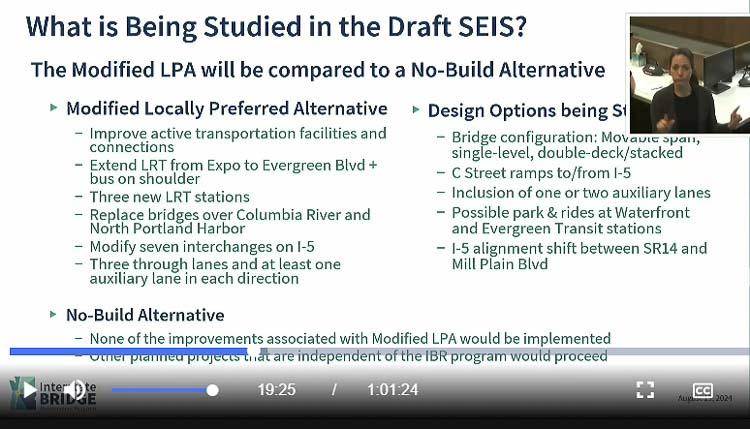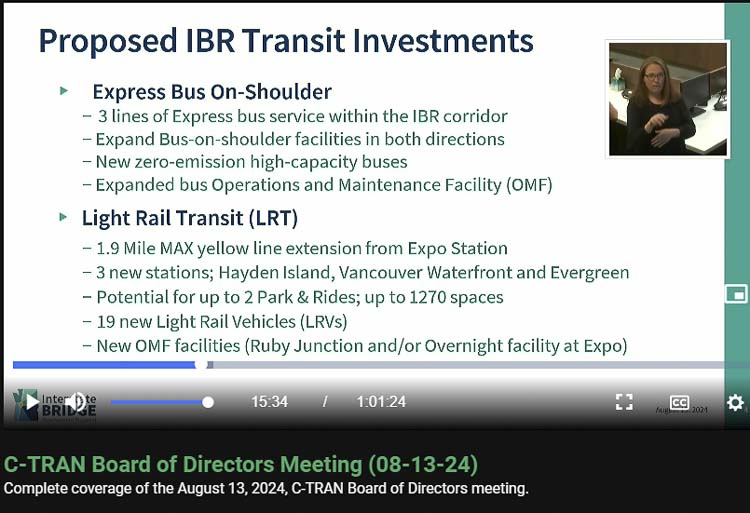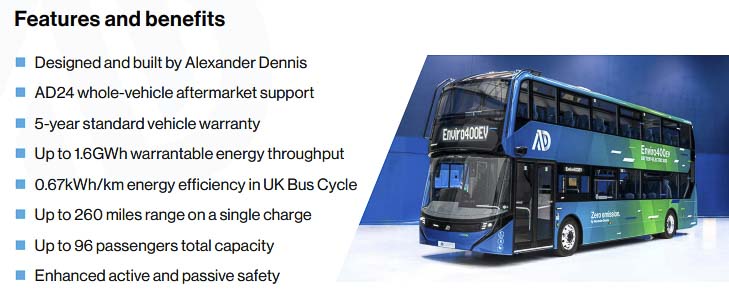C-TRAN to get eight double decker zero emission buses paid by IBR
John Ley
Clark County Today
At the Aug. 13 C-TRAN Board meeting, the Interstate Bridge Replacement Program’s (IBR) Assistant Program Administrator Frank Green gave an update on the project, including information regarding the transit component. That included Bus on Shoulder (BOS) operated by C-TRAN and a 1.9-mile MAX light rail extension operated by TriMet. Over half the surface area of the proposed bridge will be for transit, bikes and pedestrians.
Green revealed that a 10,000-page Draft Supplemental Environmental Impact Statement (DSEIS) will be released soon. They will produce a 60-page summary. The IBR team hopes to have the 60-day public comment process completed “before the holidays.” The DSEIS will compare the impacts of the Locally Preferred Alternative (LPA) with a No-Build Alternative in the year 2045.
The $1.834-billion transit component comprises over one quarter of project costs, according to the March 2023 financial plan. Last December, IBR Program Administrator Greg Johnson told the 16-member Bi-state Bridge Committee of Oregon and Washington legislators that the current $5 billion to $7.5 billion cost estimate would be going up. It was recently revealed updated costs won’t be available for another year.
The U.S. Coast Guard has not given their approval for the LPA’s requested 116-foot clearance for marine traffic, but instead is demanding at least the current 178 feet, and preferring “unlimited” clearance provided by either a bascule bridge or a tunnel.

Citizens might wonder how an environmental impact statement can be published without a valid cost estimate, without Coast Guard agreement on a bridge height, and without a final design. The amount of tolls have not been set, adding another question citizens have regarding the project.Toll rates and policies are not expected until late 2025, a year after the closing of public comment for the DSEIS.
There are 40 Vancouver single-family homes in the IBR crosshairs plus 35 floating homes on Hayden Island. These residents will be keenly interested to see how the DSEIS addresses their concerns. The release of the document has been delayed four times.
Johnson told the community “these bridges are well beyond their useful, modern life” during an online IBR presentation on the DSEIS, and therefore must be replaced. He mentioned the critical nature of freight moving up and down the west coast on I-5, yet failed to say how much time our truck drivers would save with the proposal.
The Purpose and Need statement indicated there are over 10 hours of daily congestion. Earlier IBR information revealed the program expects morning travel times to double to 60 minutes, when going from Salmon Creek to the Fremont Bridge. Furthermore, half of rush hour traffic will be stuck going zero to 20 miles per hour.
This is not a new process, but a resumption of the EIS by the former Columbia River Crossing (CRC) begun in 2004. There was a Record of Decision (ROD) in 2011, modified twice in 2012 and 2013. The IBR team is using the CRC EIS as the starting point for their DSEIS.

New C-TRAN buses for IBR
Green told C-TRAN board members they expect the project to include “new zero emission high capacity buses.” The Financial Plan indicated “battery electric express bus service would run more frequently with an expansion of bus-on-shoulder facilities along I-5 from Fourth Plain Boulevard across the Columbia River to Marine Drive.”
In response to Clark County Today questions, C-TRAN officials expect to order eight double-decker buses. They could be either battery electric or hydrogen-powered buses. C-TRAN doesn’t know the cost of the buses, but they will be paid for by the project (the IBR). They expect the buses will carry approximately 100 passengers, with details to be worked out in the future.
In 2020, King County ordered up to 120 battery-electric buses from New Flyer of America, Inc. A separate report indicates Sound Transit is getting 32 double decker Enviro 500 EV buses from Alexander Dennis. Those vehicles cost about $2.5 million a piece, inclusive of charging equipment, for a total of $80.5 million. The first batch of coaches are expected to start arriving in May 2027.
The Enviro 500 EV buses have a capacity up to 96 passengers with up to 80 seats (51 in upper deck, 29 in lower deck). They can travel up to 195 miles (354kWh battery) or 260 miles (472kWh battery) range on a single charge at the beginning of life. That compares with a range of 600 to 700 miles for a diesel bus. Charging time takes up to four hours.
Earlier this year, C-TRAN ordered 15 additional 60-foot articulated buses at a cost of $17,950,500. These 15 buses will support both current and future Vine corridors, according to Florip.
The Regional Transportation Council (RTC) reported in May there is a “new normal,” which included more people working from home and 68 percent lower transit ridership to work. The Federal Transit Administration is demanding agencies stop over-projecting transit ridership in their funding requests.

Clark County has added 39,000 new residents in the past four years, but only two more people are riding the I-5 C-TRAN Express buses on an average day. That highlights the lack of any need for “high capacity” transit over the Columbia River. Yet expensive high capacity zero emission buses and light rail continue to be the focus of the IBR project.
The majority of people want traffic congestion relief as their top transportation priority. Several community surveys indicate 78 percent of Washington residents and 70 percent of regional residents list traffic congestion and lost time as their top priority for the project. Yet over half the LPA’s bridge area is dedicated to transit and active transportation.
Will the DSEIS reflect the fact that transit ridership both locally and nationally remain below pre pandemic levels, and there is a new normal? Citizens will have the opportunity to search the 10,000 page document for 60 days to find out and make comments.
Also read:
- Rep. John Ley issues statement after Marie Gluesenkamp Perez invites the USDOT Secretary to discuss the I-5 Bridge Replacement ProjectRep. John Ley criticizes the I-5 Bridge project, arguing it prioritizes transit over reducing congestion and saving time.
- Billboards make their argument for tunnel instead of bridgeBillboards in Portland urge leaders to consider an immersed tube tunnel as an alternative to the costly Interstate Bridge Replacement Project.
- Ramp meters bringing quicker commute times to I-205 in Clark County, Feb. 11WSDOT activates the final ramp meter on I-205, aiming to improve traffic flow and reduce congestion.
- Rep. John Ley introduces bill to save Washington transportation up to $500 millionRep. John Ley introduces House Bill 1869 to block Washington from funding out-of-state transportation projects, potentially saving up to $500 million.
- Opinion: ‘The I-5 Bridge is a dead train rolling’Lars Larson argues that the proposed I-5 Bridge light rail project is financially unviable, highlighting major budget shortfalls and opposition.









